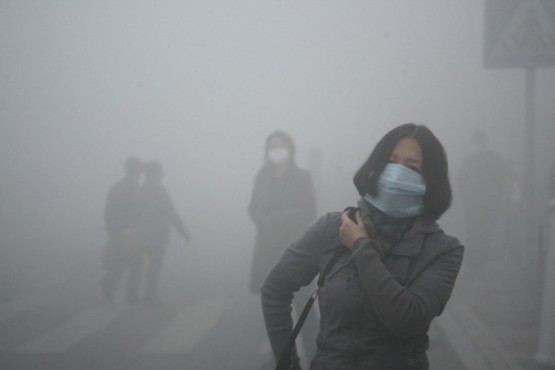According to a study by researchers at Tsinghua University and the U.S.-based Health Effects Institute, deaths caused by air pollution in China may continue to rise by 2030 despite considerable policy efforts being made to battle the country’s notorious urban smog. At The Wall Street Journal, Brian Spegele reports:
An analysis released Thursday by researchers at the Health Effects Institute, a U.S. nonprofit research organization, and Tsinghua University says premature deaths in China related to fine particulate matter known as PM2.5 could rise by as much as 40% by 2030, to around 1.3 million, from 2013 levels.
There are several reasons for the persisting high numbers of premature deaths, according to the study. China’s population over all is aging, the researchers say, so the numbers of older Chinese susceptible to cardiovascular and lung diseases related to air pollution is bound to grow. Pollution levels are unlikely to fall fast enough in a short period of time to affect that trend.
“There is no question that while China’s government has taken substantial action—and these numbers would be far worse for 2030 if they hadn’t done that— there is a significant problem,” says Dan Greenbaum, president of the Health Effects Institute, which receives funding from the U.S. Environmental Protection Agency and the automobile industry. He says more-aggressive measures are needed.
Previous studies have estimated the numbers of early deaths in China and elsewhere due to air pollution. The new research provides projections for future premature deaths and looks at the health challenges China could face as a result of severe pollution from decades of breakneck industrial growth. [Source]
The study also broke down the severity of public health damage caused by different sources of air pollution to find that coal use causes the most premature deaths in China. The New York Times’ Edward Wong reports:
Coal is responsible for about 40 percent of the deadly fine particulate matter known as PM 2.5 in China’s atmosphere, according to a study the researchers released in Beijing.
[…] The study attributed 155,000 deaths in 2013 related to ambient PM 2.5 to industrial coal burning, and 86,500 deaths to coal burning at power plants. Fuel combustion of both coal and biomass in households was another major cause of disease that year, resulting in 177,000 deaths, the study concluded.
The researchers also found that transportation was a major cause of mortality related to PM 2.5, with 137,000 deaths attributed to it in 2013. In recent years, Chinese scientists have said that motor vehicle emissions are a leading source of air pollution in cities, although not as great as coal burning. Vehicle ownership is rising fast in China, and officials, carmakers, and oil and gas companies have quarreled over setting emissions standards.
China consumes almost as much coal annually as all other countries combined, and coal burning in the country is the biggest source of both air pollution and greenhouse gas emissions, the leading cause of climate change. Chinese cities are among the most polluted in the world. Provinces in northern China, where steel, cement and power plants are common, have the highest concentrations of PM 2.5 in the country. [Source]
Reports last year showed that coal use in China fell by just over two percent in 2014, which contributed to a five percent cut in carbon emissions in early 2015. While this was welcomed as good news, subsequent studies showed that official coal consumption statistics for 2000-2013 were significantly higher than originally reported. Recent reports showed a further drop in coal use last year due to government-pledged emissions reduction efforts and a continuing economic slowdown that has hit the coal industry.
In 2014, after public anger over air pollution reached new heights, Premier Li Keqiang publicly declared “war on pollution.” In November 2014, Xi Jinping signed an informal agreement with Barack Obama pledging to cap emissions by 2030, and in June of last year Beijing submitted a formal pledge on carbon reduction to the U.N. The central government has also promised to punish local officials for decisions that negatively impact the environment, and at this year’s top political meetings in March the environment was a main topic of discussion.
A report from VOA on the Health Effects Institute study notes that India is set to overtake China in terms of pollution-related deaths, which a top researcher described as “definitely the case because India has not taken as much action.”








